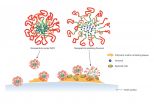Common cholesterol drug stimulates the same receptors as marijuana
New research in The FASEB Journal suggests that fenofibrate activates cannabinoid receptors and may become a viable treatment option for relieving pain, stimulating appetite, reducing nausea and preventing depression
2015-04-01
(Press-News.org) If you want the benefits of medical marijuana without the "unwanted side effects" of cannabis, new research should leave you on a high note. According to a research report appearing in the April 2015 issue of The FASEB Journal, fenofibrate, also known by the brand name Tricor®, may benefit a wide range of health issues, such as pain, appetite stimulation, nausea, as well as immune and various psychiatric and neurological conditions. This suggests that fenofibrate may be the starting point for a new class of cannabis-like drugs to treat these types of conditions.
"By illustrating the relationship between fenofibrate and the cannabinoid system, we aim to improve our understanding of this clinically important drug," said Richard S. Priestley, Ph.D., a researcher involved in the work from the School of Life Sciences at the University of Nottingham Medical School in Nottingham, United Kingdom. "Our study provides the basis for the investigation of new drugs targeting these important receptors."
To make this discovery Priestly and colleagues cultured cells containing cannabinoid receptors and exposed them to a tracer compound, which binds to cannabinoid receptors. They found that fenofibrate was able to displace the tracer, suggesting that it also binds to the receptors. Furthermore, they discovered that fenofibrate actually switched the cannabinoid receptors "on," not only in these cells, but also in sections of intestine. This led to the relaxation of the tissue in a way that mimicked what marijuana does. Despite the fact that fenofibrate has been used for many years, and its mechanism of action was presumed to be through a completely different family of receptors, this suggests that at least some of the effects of fenofibrate may be controlled by cannabinoid receptors. Furthermore, these cannabinoid receptors may be a future target for drugs used to treat pain and a variety of immune and psychiatric diseases.
"It may be difficult to persuade people in Colorado, Washington, and the District of Columbia that there are people who want the beneficial effects of marijuana without actually getting high," said Gerald Weissmann, M.D., Editor-in-Chief of The FASEB Journal, "but there are people who do not want to get stoned just to get the relief that marijuana brings. This new work suggests that possibility."
INFORMATION:
Receive monthly highlights from The FASEB Journal by e-mail. Sign up at http://www.faseb.org/fjupdate.aspx. The FASEB Journal is published by the Federation of the American Societies for Experimental Biology (FASEB). It is the world's most cited biology journal according to the Institute for Scientific Information and has been recognized by the Special Libraries Association as one of the top 100 most influential biomedical journals of the past century.
FASEB is composed of 27 societies with more than 120,000 members, making it the largest coalition of biomedical research associations in the United States. Our mission is to advance health and welfare by promoting progress and education in biological and biomedical sciences through service to our member societies and collaborative advocacy.
Details: Richard S. Priestley, Sarah A. Nickolls, Stephen P. H. Alexander, and David A. Kendall. A potential role for cannabinoid receptors in the therapeutic action of fenofibrate. FASEB J. April 2015 29:1446-1455; doi:10.1096/fj.14-263053 ; http://www.fasebj.org/content/29/4/1446.abstract
ELSE PRESS RELEASES FROM THIS DATE:
2015-04-01
The Pacific Northwest is dotted by small, low-lying, coastal cities where populations tend to cluster. These communities can be isolated and are susceptible to devastation from major storms that bring substantial wind, waves and storm surge. With climate change, it is anticipated that storms will only become more frequent and intense, signifying a need to understand how the areas will be affected.
David Hill, a researcher at Oregon State University, is focused on the hydrology and hydrodynamics in coastal areas, which represent the boundary between terrestrial and marine ...
2015-04-01
PHILADELPHIA-- Penn Medicine researchers are continuing their work in trying to understand the mechanisms through which anesthetics work to elicit the response that puts millions of Americans to sleep for surgeries each day. Their most recent study looked at ketamine, an anesthetic discovered in the 1960s and more recently prescribed as an anti-depressant at low doses. Through collaboration with the University of Pennsylvania's department of Chemistry and scientists at the Duke University Medical Center, researchers at Penn's Perelman School of Medicine have identified ...
2015-04-01
ALEXANDRIA, VA -- An updated clinical practice guideline from the American Academy of Otolaryngology--Head and Neck Surgery Foundation published today in Otolaryngology-Head and Neck Surgery identifies quality improvement opportunities and explicit actionable recommendations for clinicians managing adult sinusitis, including a greater focus on patient education and patient preference.
"More than ever before, there is a prominent role for shared decision-making between patients and clinicians when managing adult sinusitis--especially in deciding whether to use antibiotics ...
2015-04-01
In 2006 construction began on a new shopping centre in Tulln. The works unearthed various archaeologically valuable objects that were salvaged during rescue excavations. Among these objects was also the complete skeleton of a large mammal.
Large mammal uncovered during excavations in Tulln
"The partly excavated skeleton was at first suspected to be a large horse or cattle," says archaeozoologist Alfred Galik from the Institute for Anatomy, Histology and Embryology at the University of Veterinary Medicine Vienna. "But one look at the cervical vertebrae, the lower jaw ...
2015-04-01
Therapeutic agents intended to reduce dental plaque and prevent tooth decay are often removed by saliva and the act of swallowing before they can take effect. But a team of researchers has developed a way to keep the drugs from being washed away.
Dental plaque is made up of bacteria enmeshed in a sticky matrix of polymers--a polymeric matrix--that is firmly attached to teeth. The researchers, led by Danielle Benoit at the University of Rochester and Hyun Koo at the University of Pennsylvania's School of Dental Medicine, found a new way to deliver an antibacterial agent ...
2015-04-01
People who apply eyeliner on the inner eyelid run the risk of contaminating the eye and causing vision trouble, according to research by a scientist at the University of Waterloo. This is the first study to prove that particles from pencil eyeliner move into the eye.
Dr. Alison Ng, at the Centre for Contact Lens Research at Waterloo, directed the study when she was at Cardiff University in Wales. The team's findings appear in Eye and Contact Lens Science and Clinical Practice, the official peer-reviewed journal of the Contact Lens Association of Ophthalmologists.
Dr. ...
2015-04-01
If you are trying to have a baby, a good night's sleep is more important than ever. A new research report appearing in The FASEB Journal shows that the womb has its own "body clock" that needs to synchronize with the mother's body clock to ensure optimal conditions for fetal growth and development. The inability of a mother's body clock to synchronize with the womb's clock may be at least part of the reason why some women have difficulty carrying a pregnancy to full term. Specifically, the failed synchronization switches off body clock genes in cells lining the womb, which ...
2015-04-01
ANCHORAGE, Alaska -- A team of scientists led by the U.S. Geological Survey found that polar bears, increasingly forced on shore due to sea ice loss, may be eating terrestrial foods including berries, birds and eggs, but any nutritional gains are limited to a few individuals and likely cannot compensate for lost opportunities to consume their traditional, lipid-rich prey -- ice seals.
"Although some polar bears may eat terrestrial foods, there is no evidence the behavior is widespread," said Dr. Karyn Rode, lead author of the study and scientist with the USGS. "In the ...
2015-04-01
Washington, DC--Night owls are more likely to develop diabetes, metabolic syndrome and sarcopenia than early risers, even when they get the same amount of sleep, according to a new study published in the Endocrine Society's Journal of Clinical Endocrinology & Metabolism.
The study examined the difference between night and morning chronotypes, or a person's natural sleep-wake cycle. Staying awake later at night is likely to cause sleep loss, poor sleep quality, and eating at inappropriate times, which might eventually lead to metabolic change.
"Regardless of lifestyle, ...
2015-04-01
Washington, DC--Exposure to the endocrine-disrupting chemical bisphenol A during pregnancy may raise a mother's susceptibility to weight gain and diabetes later in life, according to a new animal study published in the Endocrine Society's journal Endocrinology.
A chemical used to manufacture plastics and epoxy resins, bisphenol A (BPA) is found in a variety of consumer products, including plastic bottles, food cans and cash register receipts. The U.S. Centers for Disease Control and Prevention have estimated that more than 96 percent of Americans have BPA in their bodies.
BPA ...
LAST 30 PRESS RELEASES:
[Press-News.org] Common cholesterol drug stimulates the same receptors as marijuana
New research in The FASEB Journal suggests that fenofibrate activates cannabinoid receptors and may become a viable treatment option for relieving pain, stimulating appetite, reducing nausea and preventing depression



